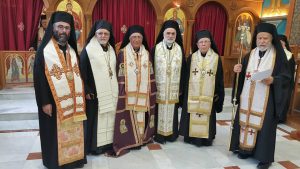St Irenaeus
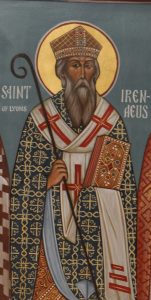 St Irenaeus was born c.130 in Smyrna, Asia Minor (today modern Izmir, Turkey) and was martyred in 202 in Lyons, France; his tomb and relics were destroyed by Calvinists in 1562 but his head rests in Saint John’s Church, Lyons, France. Today the western Church liturgically recalls Irenaeus while the Orthodox Church liturgically recalls his memory on August 23.
St Irenaeus was born c.130 in Smyrna, Asia Minor (today modern Izmir, Turkey) and was martyred in 202 in Lyons, France; his tomb and relics were destroyed by Calvinists in 1562 but his head rests in Saint John’s Church, Lyons, France. Today the western Church liturgically recalls Irenaeus while the Orthodox Church liturgically recalls his memory on August 23.
History tells us that St Irenaeus was a disciple of St Polycarp of Smyrna. In 177, was ordained and later was the Bishop of Lugdunum, Gaul (modern Lyons, France).
His learning and prudence (discretion) identified him as a true “lover of peace” which is what his name implies. You might say that Irenaeus’ enduring legacy speaks to the fact that he worked and wrote against Gnosticism (see his work Against Heresies), basing his arguments on the works of St John the Apostle, whose Gospel is often cited by Gnostics. He is considered the first great Western ecclesiastical writer and theologian, who emphasized the unity of the Old and New Testaments, and of Jesus Christ’s simultaneous human and divine nature, and the value of tradition. The calls Irenaeus a “Father of the Church”. He is clearly among the “greats”.
As one said, “Emerging from the turmoil of the second century, the Church is indebted to Irenaeus for its catholic self-consciousness and its awareness of unity as reflected in the emergence of the canon of Scripture, the interpretation of prophecy, and apostolic succession.”
Milan Lach appointed to Parma Eparchy
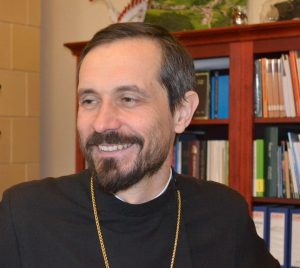 Today, the Holy Father appointed Bishop Milan Lach, SJ, as Apostolic Administrator for the Eparchy of Parma (OH). He is currently auxiliary bishop of Prešov of the Byzantines, Slovakia.
Today, the Holy Father appointed Bishop Milan Lach, SJ, as Apostolic Administrator for the Eparchy of Parma (OH). He is currently auxiliary bishop of Prešov of the Byzantines, Slovakia.Sacred Heart
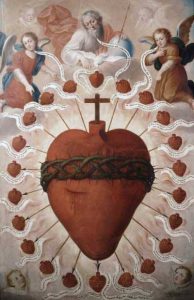 From the Revelations of Our Lord to St. Mary Margaret Alacoque:
From the Revelations of Our Lord to St. Mary Margaret Alacoque:
“And He [Christ] showed me that it was His great desire to be loved by all people and to withdraw them from the path of ruin that made Him form the design of revealing His Heart to all people, with all the treasures of love, of mercy, of grace, of sanctification and salvation which it contains, in order that those who desire to give Him all the honour and love possible, might themselves be abundantly enriched with those divine treasures of which His heart is the source.”
Heart of Jesus, have mercy on us.
Maximilian Buonocore ordained priest
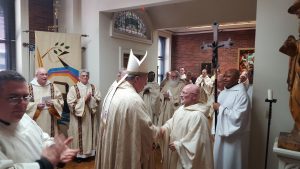 Waterbury, CT native DOM Maximilian Peter Buonocore, OSB, 60, was ordained priest of Jesus Christ today by Joseph Cardinal Tobin, CSsR, the archbishop of Newark.
Waterbury, CT native DOM Maximilian Peter Buonocore, OSB, 60, was ordained priest of Jesus Christ today by Joseph Cardinal Tobin, CSsR, the archbishop of Newark.
The new priest, Father Maximilian, is a Benedictine monk of Newark Abbey. He’s the first priest ordained there in a few decades.
The monks of Newark Abbey operate St. Benedict’s Prep, St Mary’s Grammar School and the priests assist locally in parishes and convents.
Father Maximillian’s First Mass is Sunday at the Abbey.
Fisher and More
 “… many stood for Christ against the State, and they were felled for it – martyred for Faith in Jesus Christ and for clinging to the Truth he taught – Truth handed on faithfully from generation to generation by Christ’s holy Church. But of the hundreds who were martyred for the Catholic Faith from 1535 onwards, two are especially eminent, and they were the first to be canonised by Pope Pius XI in 1935. St John Fisher was the saintly Bishop of Rochester, Chancellor of Cambridge University, Tutor to Henry VIII, Confessor to Lady Margaret, mother of Henry VII. Erasmus considered him to be “incomparable for uprightness of life, for learning and for greatness of soul.” In short, he was an luminary of the Church. St Thomas More was a luminary of the State. He was Lord High Chancellor of England, a noted Humanist philosopher and lawyer, and a Scholar.
“… many stood for Christ against the State, and they were felled for it – martyred for Faith in Jesus Christ and for clinging to the Truth he taught – Truth handed on faithfully from generation to generation by Christ’s holy Church. But of the hundreds who were martyred for the Catholic Faith from 1535 onwards, two are especially eminent, and they were the first to be canonised by Pope Pius XI in 1935. St John Fisher was the saintly Bishop of Rochester, Chancellor of Cambridge University, Tutor to Henry VIII, Confessor to Lady Margaret, mother of Henry VII. Erasmus considered him to be “incomparable for uprightness of life, for learning and for greatness of soul.” In short, he was an luminary of the Church. St Thomas More was a luminary of the State. He was Lord High Chancellor of England, a noted Humanist philosopher and lawyer, and a Scholar.
The combination of these two Saints reminds us that neither spiritual nor temporal lords could stand against the State and the will of the Crown. Nevertheless, both men remained steadfast in upholding the Truth of the Gospel, particularly concerning the indissolubility of Christian marriage. For their fidelity to Christ’s Word, they were executed in 1535, St John Fisher on this day (22 June), and St Thomas More on 6 July.
In our own time, the teaching of Christ on the permanence of Christian marriage, and thus the refusal to accept divorce, is largely seen as irrelevant or outdated. And, it appears, that some, even within the Catholic Church, regard this stance to be “rigid” and lacking in “mercy”. And yet, today’s Saints clung to the perennial teaching of Christ, and they were willing to die for this Truth. They died not simply as ‘conscientious objectors’ but, more fundamentally, as witnesses to the Truth of the Gospel. Truth is everlasting and it is not changed to suit us, but rather, we must conform to the Truth, above all, to the Person of Jesus Christ and to his teachings. Today’s Martyrs taught this with their lives.
Fr Lawrence Lew, OP
excerpt, homily for the feast of Ss. John Fisher and Thomas More, 2017
Joseph Absi new Melkite Patriarch
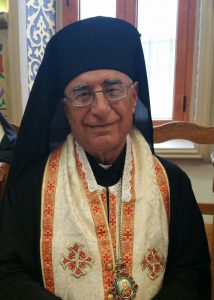 Archbishop Joseph Absi, Patriarchal Vicar for Damascus, has been elected as the new Melkite Patriarch. Axios!
Archbishop Joseph Absi, Patriarchal Vicar for Damascus, has been elected as the new Melkite Patriarch. Axios!
His Beatitude succeeds Patriarch Gregory.
The new Patriarch celebrated his 71st birthday yesterday. He is 44 years a priest and 15 years a bishop and a member of the Melkite Paulist Order.
His Beatitude is an American citizen, since 1990. His mother and older brother live in California.
Eis pollá eti Déspota!
Itala Mela beatified
 On Saturday, June 10th, Itala Mela (1904-57) was beatified in La Spezia, Italy, her home town. Cardinal Angelo Amato, the prefect of the Congregation for the Causes of Saints, offered Mass and declared Mela a Blessed of the Church in the presence of 3000 people.
On Saturday, June 10th, Itala Mela (1904-57) was beatified in La Spezia, Italy, her home town. Cardinal Angelo Amato, the prefect of the Congregation for the Causes of Saints, offered Mass and declared Mela a Blessed of the Church in the presence of 3000 people.
The liturgical memorial of Blessed Itala Mela will be April 28, the day prior to her anniversary of death so not to conflict the feast of St. Catherine of Siena, one of the patron saints of Italy.
In previous posts on Mela, I noted she was an Italian laywoman who eventually found her vocation not as a Benedictine nun but as a Benedictine Oblate.
Itala Mela was a well-known mystic of the Church, her popularity certainly grew following her death. She was the author of several theological writings that focused on the Blessed Trinity.
In his June 11th, Trinity Sunday Angelus Address, Pope Francis said that Blessed Itala Mela was not raised in the Catholic Faith, and in fact she identified herself as an atheist following her brother Enrico’s death at the age of nine in 1920. The tragic loss sent her in a tail-spin.
She later converted to Christ, however, following an intense spiritual experience on the Feast of the Immaculate Conception (1922) at the age of 18. This sudden reawakening of her faith prompted her to say with conviction: “Lord, I shall follow You unto the darkness, unto death.” Her mission was to assist Catholic university students in developing their God-given, human desires through an emphasis on the spiritual life.
Mela’s own spiritual path was not straight but she eventually recognized that consecrated life was not her vocation; then she became a Benedictine Oblate in 1933 of the Abbey of Saint Paul outside the Walls in Rome and undertook a mystical journey focused on the mystery of the Most Holy Trinity taking the name Maria of the Blessed Trinity. Among her guides were Blessed Alfredo Ildefonso Schuster, OSB (1880-1954), a Benedictine monk (of St Paul’s in Rome) who later became the Cardinal-Archbishop of Milan and Blessed Paul VI, also of Milan and later the Roman Pontiff.
Typically, Oblates promise the three Benedictine vows of Conversatio, Obedience and Stability, yet she also made a fourth vow of consecration to the Holy Trinity which she considered as her mission in the Church and world.
It was very fitting that Mela was beatified on the solemnity of the Holy Trinity. The Pope also said that “The testimony of the new Blessed encourages us, during our journeys, to often direct the thoughts to God the Father, Son and Holy Spirit who dwells in the cell of our heart.”
Blessed Itala Mela now becomes a sign of holiness not only for the entire Church, but in particular for the laity. In fact, Cardinal Amato said in his homily, “Society needs secular holiness, education, economics, family, politics. The world needs lay saints.”
Blessed Itala, pray for us.
St. Anthony of Padua
“In 1946 Venerable Pope Pius XII proclaimed Anthony a Doctor of the Church, attributing to him the title “Doctor Evangelicus”, since the freshness and beauty of the Gospel emerge from these writings. We can still read them today with great spiritual profit.”
– Benedict XVI
St. Anthony of Padua, pray for us.
Bee Blessing
 Dominican Father Jonathan Kalisch blessing the bees and the hives at Our Lady of Grace Monastery, North Guilford. For us, asking for God’s blessings upon things helps to remember God’s goodness and constant care for us. As a gardener, I am keenly reminded that without the bees we would not be eating too well, plus the honey produced by the bees is part of our diet and good health since it has curative properties. As a Catholic I can’t help not remembering the references to bees in the Exultet sung at the Paschal Vigil. There we hear:
Dominican Father Jonathan Kalisch blessing the bees and the hives at Our Lady of Grace Monastery, North Guilford. For us, asking for God’s blessings upon things helps to remember God’s goodness and constant care for us. As a gardener, I am keenly reminded that without the bees we would not be eating too well, plus the honey produced by the bees is part of our diet and good health since it has curative properties. As a Catholic I can’t help not remembering the references to bees in the Exultet sung at the Paschal Vigil. There we hear:
This is the night of which it is written:
The night shall be as bright as day, dazzling is the night for me, and full of gladness. The sanctifying power of this night dispels all wickedness, washes faults away, restores innocence to the fallen, and joy to mourners, drives out hatred, fosters concord, and brings down the mighty. On this, your night of grace, O holy Father, accept this candle, a solemn offering, the work of bees and of your servants’ hands, an evening sacrifice of praise, this gift from your most holy Church.
But now we know the praises of this pillar, which glowing fire ignites for God’s honor, a fire into many flames divided, yet never dimmed by sharing of its light, for it is fed by melting wax, drawn out by mother bees to build a torch so precious.
BLESSING OF BEES
P: Our help is in the name of the Lord.
All: Who made heaven and earth.
P: The Lord be with you.
All: And with your spirit.
Let us pray.
Lord God almighty, who made the heavens and the earth, and all living things in the air and on land for the use of mankind; You hold all creation in the palm of your hands. With compunction, we pray to You, O all-good One: as in ancient times You granted the Israelites a land flowing with milk and honey, and as you were well-pleased to nourish Your baptizer John in the wilderness with wild honey. You ordered, through the ministers of holy Church, that candles made from the industry of bees should be lighted during the solemn mystery in which the most sacred body and blood of Jesus Christ, your Son, is confected and consumed; send your blessing + upon these bees and these beehives. Let none of these hives which You have fashioned be deprived of bees, but let them always be filled with honeycomb causing them to multiply, to produce and to be kept from harm, so that their yield of wax can be turned to your honor, to that of the Son and Holy Spirit, and to the veneration of the blessed Virgin Mary; through Christ our Lord.
All: Amen.
~ Our Lady of Grace, pray for us.
~ St. Ambrose, St. Bernard of Clairvaux, and Blessed Solanus Casey, pray for us.
~ Blessed Simon Bellachi, pray for us.
The bees and the hives are sprinkled with holy water.
There are several pieces of sacred Scripture that reference honey and bees. My favorite is: “The bee is small among flying creatures, but what it produces is the best of sweet things” (Sirach 11:3). AND the 4th century author of The Apostolic Constitutions, one of the early documents of the Church writes: “Or else go to the bee, and learn how laborious she is, and her work how valuable it is, whose labors both kings and mean men make use of for their health. She is desirable and glorious, though she be weak in strength, yet by honoring wisdom she is improved, etc.”
The Church, the body of Christ, is a lot like a beehive: everyone has a God-given mission, a particular job to do for the Lord and the Kingdom.

